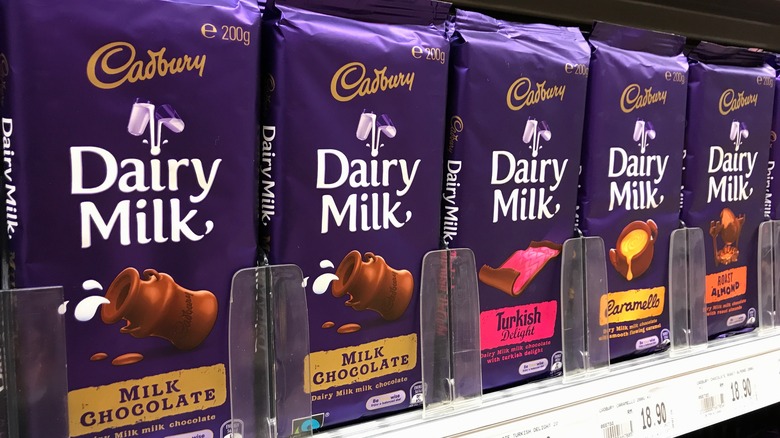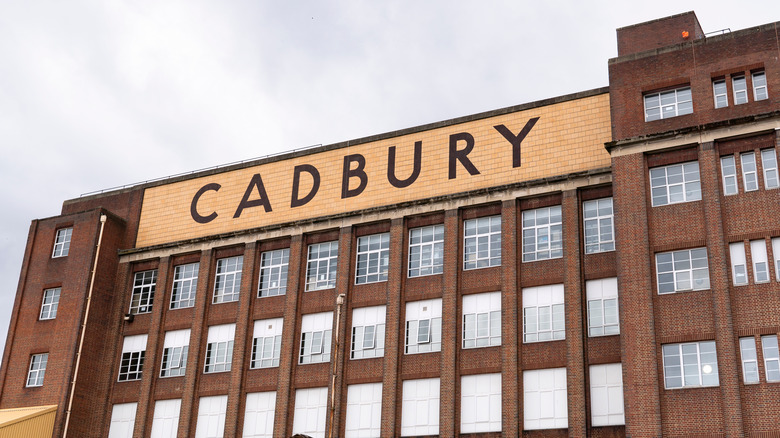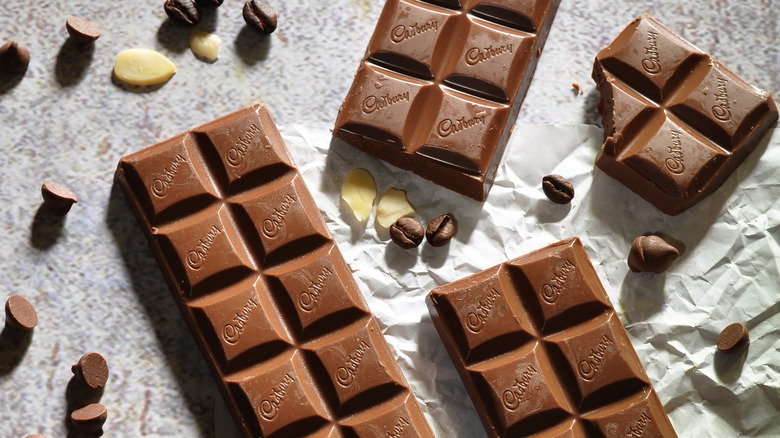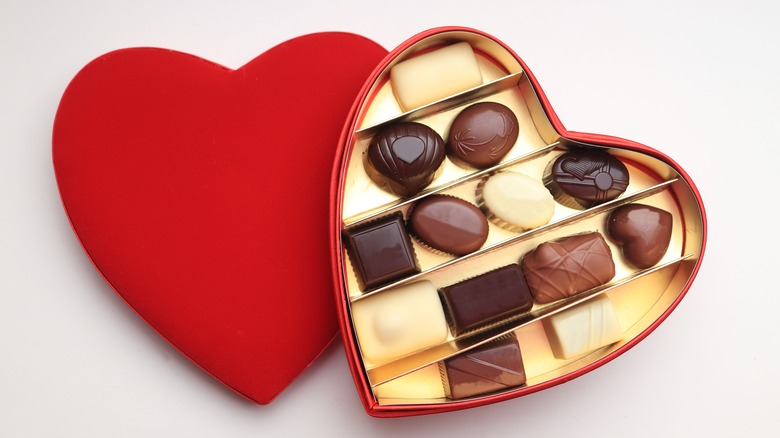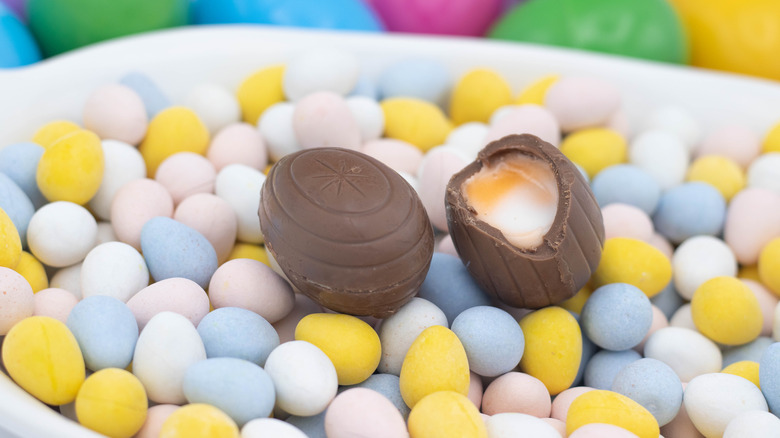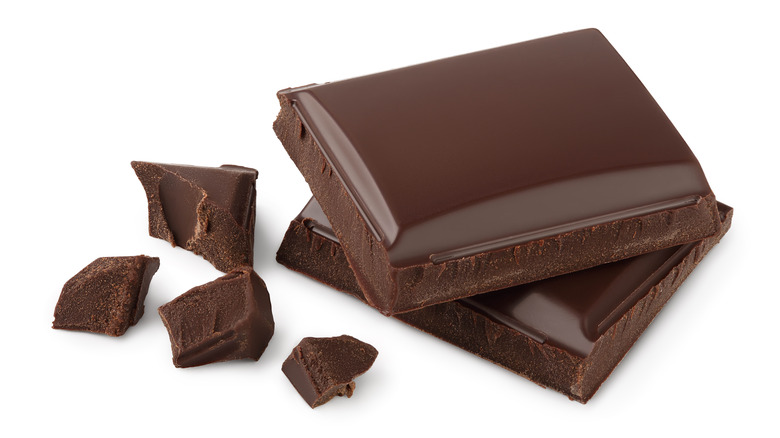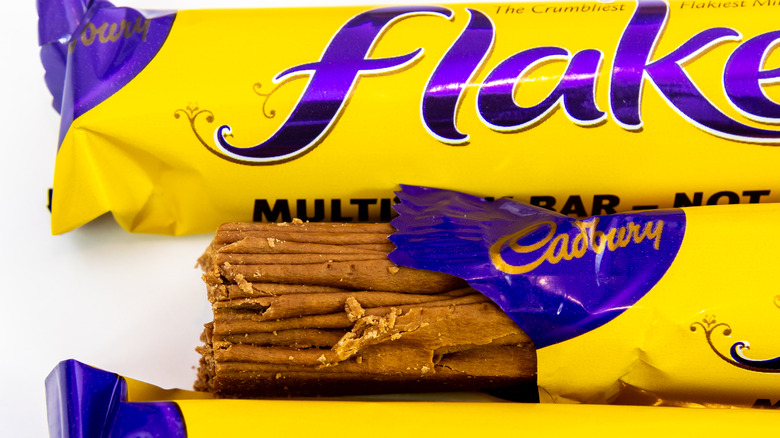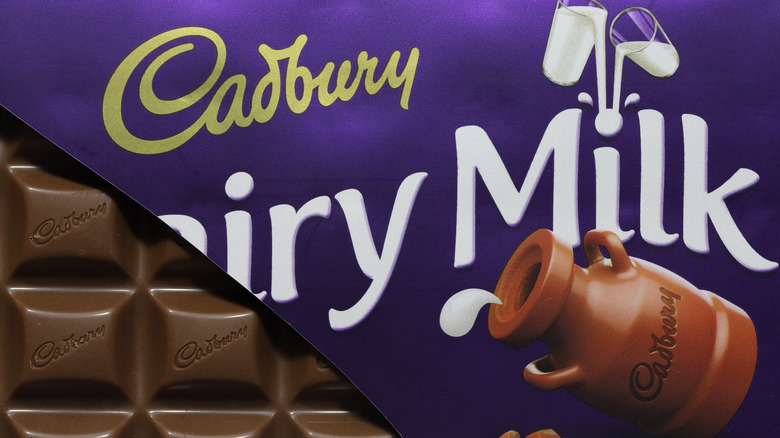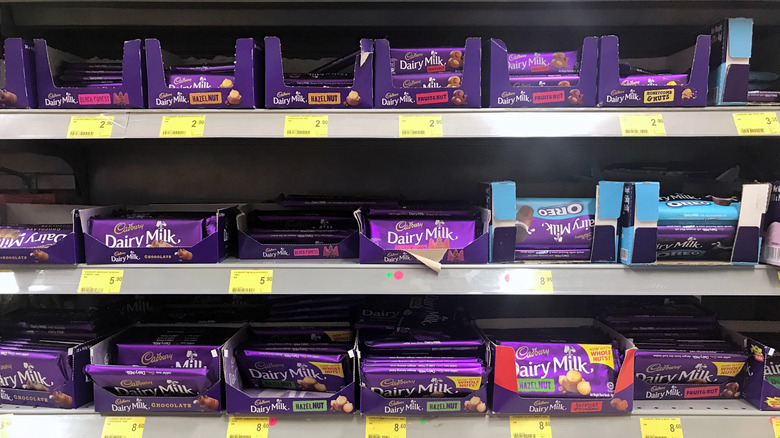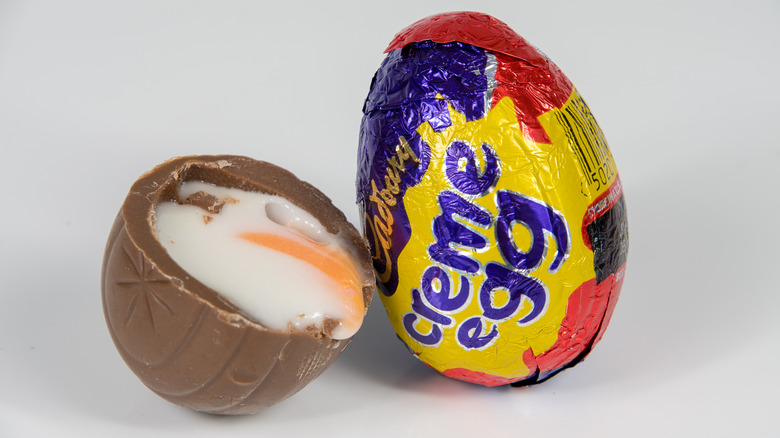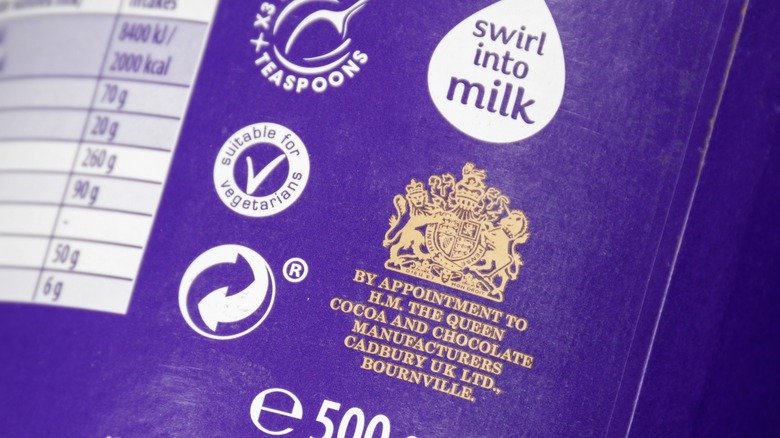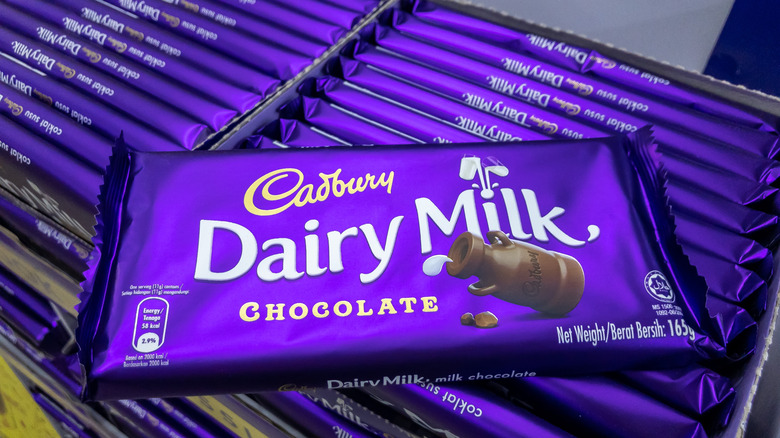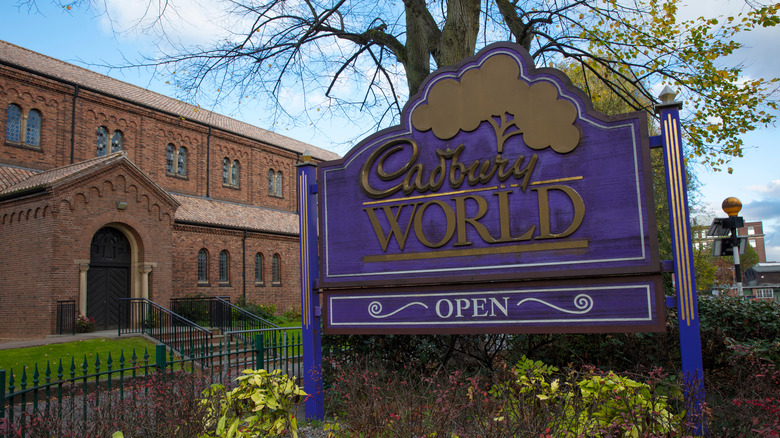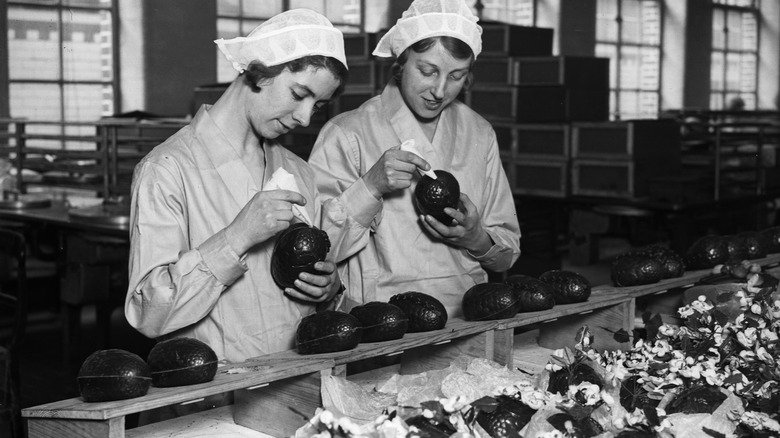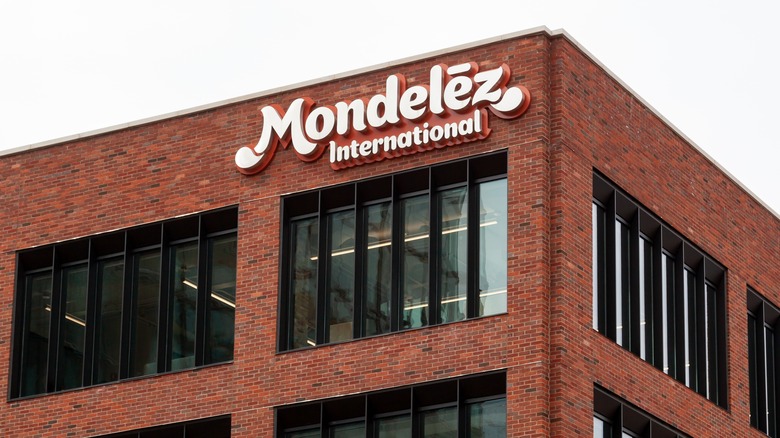15 Sweet Facts About Cadbury Chocolate
Cadbury Dairy Milk is a popular brand. In the United States, it may be most well-known for its Easter chocolates, particularly the famous Cadbury Creme Eggs. However, the company also makes a range of other sweet treats. Some of these other tasty offerings include Cadbury Shimmer Mini Eggs, Cadbury Chocolate Bars, Cadbury Mini Snow Balls, and Cadbury Caramello bars. Even if you've had your share of Cadbury products, there could be a lot you don't yet know about this brand.
Do you know how Cadbury got its start? Were you aware that Cadbury was the inspiration for "Charlie and the Chocolate Factory?" Would you like to learn more about how Cadbury played an instrumental role in getting workers time off for bank holidays? Perhaps, you'd like to know more about how the company got into a legal dispute while trying to trademark a specific color? Cadbury's history stretches back decades and is full of intriguing stories. Read on to learn 15 sweet facts about Cadbury chocolate.
John Cadbury founded the company in 1824
Cadbury's history can be traced back to 1824. Back then, a British man named John Cadbury decided to open a grocery store in Birmingham, England. Cadbury was a Quaker. Like other Quakers, he believed that drinking alcohol was bad. In response, he sought to sell different beverages that could take its place. Cadbury's shop offered coffee and tea as alcohol alternatives. The store also sold drinking chocolate and hot cocoa. These sweeter beverages were made for customers using a mortar and pestle.
After experiencing initial success with this Birmingham shop, Cadbury decided to branch out. In 1831, he purchased a large warehouse building to expand the manufacturing side of his business. It didn't take too long for Cadbury's business to grow. The company began to offer several different chocolate-based products. Cadbury was making 11 types of cocoa and 16 types of drinking chocolate by 1842.
It was a while before Cadbury starting selling candy
It wasn't until 1897 — several decades after the company was founded — that Cadbury made its first chocolate bar. The company's initial recipe used excess cocoa butter that was left over from the production of other Cadbury products. Rather than letting these leftovers go to waste, Cadbury began using this cocoa butter to make milk chocolate bars. However, these first bars were not an immediate hit with the public.
By 1904, one of founder John Cadbury's grandsons was pushing for a change. The son, named George Cadbury Jr., wanted the company to make a cutting-edge milk chocolate bar. George Jr. wanted to incorporate more milk to make the chocolate bars taste extra creamy. After some trial and error, the first Dairy Milk bars were released. This time, the bars quickly became popular. By the start of World War I, these new milk chocolate bars were Cadbury's number one selling product.
We can thank the company for heart-shaped chocolate boxes
Heart-shaped boxes filled with delicious little candies are one of the first things that come to mind around Valentine's Day. It turns out that we can thank Cadbury for these chocolate boxes. Richard Cadbury, son of company founder John Cadbury, helped to popularize them.
These boxes came about when Richard was looking for ways to increase chocolate sales. His solution was to create high-quality vessels for the chocolates to be sold inside. This way, the boxes could contribute some additional value to the product. Instead of getting just candy, you'd also get a decorative container.
Richard began designing these intricately-decorated boxes himself. Since Valentine's Day was an annual holiday at this point in history, it didn't take long for Cadbury's boxes to take on the heart shape. Heart-shaped Cadbury chocolate boxes began to be sold in celebration of this romantic day.
Cadbury Easter eggs debuted in 1875
Cadbury's Easter chocolates are some of the company's most iconic products. This popularity didn't come out of anywhere. It turns out that Cadbury released its first Easter eggs as far back as 1875. But back then, these eggs looked a little different. For one thing, the filling was distinct. Instead of a soft interior, the inside was stuffed with dragées, little drops of chocolate coated with sugar. Also, the egg's exterior was made with dark chocolate.
By this point in the company's history, the now-popular Cadbury Creme Egg was still nearly a century away from its debut. It wasn't until 1971 that the company released what would become a customer favorite. After that, it took a few years for Cadbury Creme Eggs to achieve a more widespread level of popularity. Television advertisements played a big role in them finally taking off. Today, Cadbury reportedly makes around 500 million Creme Eggs per year.
World War II saw the introduction of Ration Chocolate
World War II had an impact on many industries, including food. Cadbury was not left untouched by this war. During the conflict, there was often a shortage of materials and fresh foods. This caused governments to begin rationing supplies and implement laws surrounding certain high-demand food items. As part of its rationing efforts, the United Kingdom placed restrictions on milk, such as banning manufacturers from using fresh milk to make food products. This impacted Cadbury, which used fresh milk to make some of its chocolate goods.
The company had to get creative since Cadbury couldn't make its signature Dairy Milk bars without milk. It developed a new product called Ration Chocolate. Its recipe used dried milk powder in place of milk. While this new chocolate bar was unable to rival the creamy texture of a Dairy Milk bar, it was a good stand-in given the circumstances.
Cadbury Flakes started out as a mistake
One of Cadbury's most popular products is its Cadbury Flake bars. The texture of these chocolate bars is unique. Instead of being soft and uniform, Flake bars are deliciously crumbly. While the Cadbury Flake's exact recipe is not public knowledge, the way this scrumptious chocolate bar came to be isn't a secret.
The bar's invention was a happy accident. Cadbury Flake's story begins with an oven malfunction. In 1920, a machine broke down at one of Cadbury's factories. The device stopped working with several chocolates still inside of it. The chocolates were initially left alone so that they could cool down. After some time, factory workers attempted to open up the machine. Inside, they found that the chocolate had been shaped into thin, hard layers. The workers discovered that the layers could be broken into delicious flakes. Thanks to this oven breakdown, the beloved Cadbury Flake bar was born.
American and British Cadbury chocolate taste different
If you've ever tasted both American Cadbury chocolate and British Cadbury chocolate, you might have noticed a difference in flavor. You are not imagining things. These chocolates are different from one another. One major difference is in manufacturers. In the U.S., Cadbury chocolate is manufactured by Hershey. Imports of Cadbury chocolate made in the U.K. were banned starting in 2015.
Cadbury also uses different recipes depending on which country its chocolate is made in. With Cadbury chocolate manufactured in the U.K., milk is the main ingredient. With the company's chocolate made in the U.S., sugar is the main ingredient. This is why British Cadbury chocolate has a higher fat content and tastes creamier.
But there are more discrepancies between the two country's chocolates. They can also look different on the surface. Both bars are partitioned into individual sections, but the U.K. version has slightly raised cubes, while those on the U.S. bars are flatter.
Kraft purchased the company in 2010
Kraft Foods bought Cadbury in 2010. The $19 billion takeover deal was eagerly sought after by Kraft, which was looking to expand its portfolio. But Cadbury was more hesitant. Before agreeing to the takeover, the chocolate brand considered merging with Hershey. Merging with Hershey seemed like a better fit to some, because of the similar product lines and the hope that Cadbury would retain more control of its operations. However, the deal with Kraft eventually went through.
Part of Kraft's motivation to take over Cadbury may have come from its plans to split itself into two different companies. One would be a snack company, and one would be a grocery company. In 2012, shortly after the Cadbury takeover wrapped up, this split occurred. The new snack division was named Mondelēz International. The grocery company was dubbed the Kraft Foods Group. Mondelēz International then became the parent company of Cadbury. Oreo, Nabisco, Trident, and other brands are also part of Mondelēz.
Consumers weren't happy when Cadbury changed its Creme Egg recipe
Cadbury Creme Eggs have been a customer favorite for a long time. But the treats haven't always maintained a perfect reputation. Once, Cadbury did something that brought criticism to its Creme Eggs: a recipe change.
This shift took place in 2015, a few years after Kraft acquired the company. At the time, Cadbury announced that the type of chocolate used for its eggs' shells would change. It would no longer be made using the U.K. version of the company's famous Dairy Milk chocolate. This change was unacceptable in the eyes of many U.K. residents, who thoroughly enjoyed the creamy Dairy Milk chocolate used in the old recipe. Many took to Twitter and other media platforms to blast the company. They felt like Cadbury was damaging the Creme Egg's tried-and-true recipe.
But this isn't the only time that the Cadbury Creme Egg recipe has changed. It appears to have shifted several times since 2015.
Cadbury inspired Charlie and the Chocolate Factory
You may have seen the movies or read the book, but you may not know that "Charlie and the Chocolate Factory" was inspired by the Cadbury company. It all started with novelist Roald Dahl. When he was 13, Dahl attended a school that received free samples of Cadbury chocolate. This allowed Dahl to be a Cadbury chocolate taster while still in school. Students received these candies so that they could try them and share their thoughts with the company. Tasting these chocolates filled Dahl with images of the inside of an amazing chocolate factory. He was intrigued by the idea of grown men having a career driven by candy.
It wouldn't be until several years later that Dahl would use these childhood fantasies to write "Charlie and the Chocolate Factory." He didn't start writing it until 1960, approximately 30 years after his boarding school days. The book was first published in 1964, and would eventually inspire several famous films.
The company supplied the royal family with chocolate
A Royal Warrant of Appointment is a special acknowledgment granted to companies supplying food and other items to the Royal Family. This recognition is awarded by certain members of the Royal Family, who are called Grantors. Cadbury has received several of these warrants.
The company was granted its first Royal Warrant by Queen Victoria, in 1854. While Royal Warrants had been issued by monarchs for hundreds of years, Queen Victoria issued almost 2,000 of them during her time on the throne. She also released new rules for companies that receive warrants, regarding how each could display or use these warrants.
Since the end of Queen Victoria's reign, Cadbury has received Royal Warrants from other British monarchs. Queen Elizabeth II awarded the company a Royal Warrant in 1955. Today, approximately 800 companies and individuals hold Royal Warrants for a variety of goods and services.
Cadbury and Nestle fought over a trademark for the color purple
While many people primarily remember the name of a treat, others may remember what the packaging looks like. Cadbury started using a specific shade of purple, called Pantone 2685C, nearly two centuries ago. This shade was used to create its packaging. Founder John Cadbury selected the color to pay homage to Queen Victoria. In 1995, the company took steps to register a trademark on this color, hoping to prevent other companies from mimicking its packaging.
Nestle, one of Cadbury's main competitors, opposed this. It didn't think it was fair for Cadbury to trademark a color. In 2012, the U.K.'s High Court ruled on the case, siding with Cadbury.
But the battle did not end there. Finally, the debate was decided in 2019. Unfortunately, Cadbury was on the losing side. The company was told that it was not specific enough about its choice of purple. The ruling made it legal for other brands to choose Cadbury's beloved shade of Pantone 2685C.
Fans of the chocolate company can visit Cadbury World
If you're a true Cadbury fan — or maybe you are just looking for a good time — you can visit Cadbury World. This museum-like attraction is located in Birmingham, England, and was created by the company to share its interesting history. Cadbury World opened in 1990 and now sees roughly 500,000 visitors every year. Cadbury World is particularly suited to families with younger children.
Cadbury World is divided into 14 different zones. Each one includes various interactive components, videos, staff demonstrations, and other features meant to help share information with visitors. One of these features is a special 4D chocolate adventure. In this, visitors can enjoy a unique take on chocolate making. In addition to learning about the history of the company and seeing how some of its delicious chocolate treats are made, visitors can also go on rides inspired by Cadbury's many different chocolate products.
It started the trend of giving employees time off for bank holidays
If you like having bank holidays off, you should thank Cadbury. After John Cadbury's sons took over the family business, they wanted to help improve the lives of factory workers in Birmingham. Company leaders made several changes to benefit Cadbury workers.
Cadbury added kitchens to company factories. This way, workers could make themselves lunch. Heat was also added to the dressing rooms. Cadbury even subsidized train fares for employees commuting to and from work. The chocolate company even built homes and swimming pools for certain employees.
Cadbury was also the first company to cut the workweek to just five and a half days. This was a reduction from six days, which was standard at the time. In addition to getting Sundays off, Cadbury employees were also off on Saturday afternoons. Cadbury also started the tradition of giving employees bank holidays off, which was later picked up by other companies.
Its current parent company is one of the world's largest confectionery brands
Mondelēz is the snack division of Kraft Foods, as well as the current parent company of Cadbury. It is currently the third-largest confectionery brand in the world. The Ferrero Group is the second largest. Mars Wrigley Confectionery is the largest.
Cadbury is just one of the numerous chocolate brands under the Mondelēz corporation. Some of the other brands under the company include Milka and Toblerone.
As of 2022, Mondelēz employed approximately 80,000 workers and operated 133 manufacturing plants. Mondelēz tried to grow its company even more by purchasing Hershey, the fifth-largest confectionery brand, in 2016. However, Hershey was not interested in being bought by Mondelēz at the time. Adding Hershey to its brands would have allowed Mondelēz to greatly increase in size. It also would have added 14 more plants and over 16,000 employees to its roster, if Mondelēz were to buy Hershey today.
